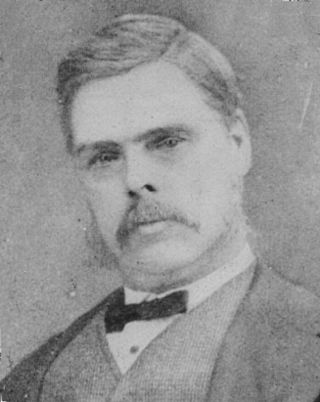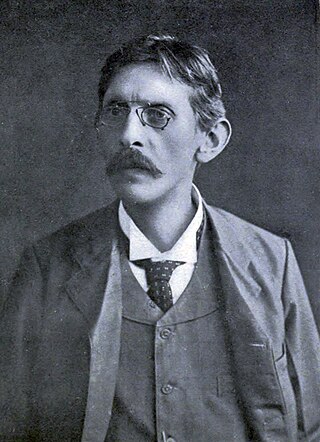
Allan Octavian Hume, CB ICS was a British political reformer, ornithologist, civil servant and botanist who worked in British India, who founded the party Indian National Congress. He supported the idea of self-governance by Indians. A notable ornithologist, Hume has been called "the Father of Indian Ornithology" and, by those who found him dogmatic, "the Pope of Indian Ornithology".

The white-shouldered ibis is a large species of bird in the family Threskiornithidae. It is native to small regions of Southeast Asia, and is considered to be one of the most threatened bird species on this part of the continent.

Howard Saunders was a British businessman, who later in life became a noted ornithologist, specialising in gulls and terns.

The red-naped ibis also known as the Indian black ibis or black ibis is a species of ibis found in the plains of the Indian Subcontinent. Unlike other ibises in the region it is not very dependent on water and is often found in dry fields a good distance away from water. It is usually seen in loose groups and can be told by the nearly all dark body with a white patch on the shoulder and a bare dark head with a patch of crimson red warty skin on the crown and nape. It has a loud call and is noisy when breeding. It builds its nest most often on the top of a large tree or palm.

Francis Talbot Day was an army surgeon and naturalist in the Madras Presidency who later became the Inspector-General of Fisheries in India and Burma. A pioneer ichthyologist, he described more than three hundred fishes in the two-volume work on The Fishes of India. He also wrote the fish volumes of the Fauna of British India series. He was also responsible for the introduction of trout into the Nilgiri hills, for which he received a medal from the French Societe d'Acclimatation. Many of his fish specimens are distributed across museums with only a small fraction deposited in the British Museum, an anomaly caused by a prolonged conflict with Albert Günther, the keeper of zoology there.

Frank Finn FZS, MBOU was an English ornithologist.

The white-bellied heron also known as the imperial heron or great white-bellied heron, is a large heron species living in the foothills of the eastern Himalayas in northeast India and Bhutan to northern Myanmar. It inhabits undisturbed rivers and wetlands. It has been listed as Critically Endangered on the IUCN Red List since 2007, because the global population is estimated at less than 300 mature individuals and threatened by habitat loss and human disturbance. It is mostly dark grey with a white throat and underparts.

Colonel Robert George Wardlaw-Ramsay FLS, FZS was an army officer and naturalist. His father was Robert Balfour Wardlaw-Ramsay while his mother Louisa was the third daughter of George, eighth Marquess of Tweeddale. He studied at Cheam and Harrow before joining the Hampshire Regiment in January 1871 to be stationed in India, Afghanistan and Burma. His interest in birds began as a young boy and in 1872 he was elected a member of the British Ornithologists' Union and was later (1913-1918) to become its president. He was also a Fellow of the Zoological Society. During his various army postings he took a great interest in the local ornithology. He was a nephew of Arthur Hay, 9th Marquess of Tweeddale and inherited a large collection of over 20,000 bird skins that was later presented to the British Museum. He also edited The Ornithological works of Arthur 9th Marquis of Tweeddale (1881) and towards the end of his life was writing a Guide to the birds of Europe and North Africa (1923) which was published posthumously.

Allan Cyril Brooks was an ornithologist and bird artist who lived in Canada. His father William Edwin Brooks had been a keen ornithologist in India but growing up in a farming household in Canada made his entry into the career of bird art much more difficult than for his contemporary Louis Agassiz Fuertes in the United States of America. His painting style was more impressionist with a greater emphasis on the habitat than on fine details of plumage. After Fuertes' death in a road accident, he was commissioned to complete the plates for Birds of Massachusetts.
Davison's leaf warbler or the white-tailed leaf warbler, is a species of leaf warbler. It was formerly included in the "Old World warbler" assemblage.

The Palani laughingthrush is a species of laughingthrush endemic to the hills of the Western Ghats south of the Palghat Gap in Southern India. Found in the high montane forests, this grey bibbed, rufous bellied bird with a prominent dark eyestripe and broad white brow was grouped along with the grey-breasted subspecies of the black-chinned laughingthrush and known as the grey-breasted laughingthrush. This species is found in the Palni Hills while another closely related form, the Ashambu laughingthrush with a shorter white brow is found in the high hills south of the Achankovil Gap and was treated as a subspecies. The two forms were together treated under the name of Kerala laughingthrush.

Abbott's babbler is a species of bird in the family Pellorneidae. It is widely distributed along the Himalayas in South Asia and extending into the forests of Southeast Asia. They are short-tailed and stout birds which forage in pairs in dense undergrowth close to the ground and their presence is indicated by their distinctive calls.
Not to be confused with American mechanical engineer William Lamont Abbott

William Theobald was a malacologist and naturalist on the staff of the Geological Survey of India serving in Burma, then a part of British India.

Karl Richard Hanitsch was a German-born entomologist and museum curator who served as the director of the Raffles Museum in Singapore in the early 20th century.

Blanford's bridle snake, also known commonly as Blanford's bridal snake, is a species of harmless snake in the family Colubridae. The species is endemic to Asia. Blanford's bridle snake is so named because its slim body resembles the bridle used to control horses.
Johann Wilhelm Helfer also known as Jan Vilém Helfer was a Bohemian physician, explorer and naturalist. He died in the Andaman Islands, after the group he was in was attacked by natives with arrows. Many of the plants he collected went to Kew and nearly 140 species were named after him.

George William Vidal was a British lawyer who worked in the Indian Civil Services in the Bombay Presidency and contributed to natural history studies from the Konkan region, and was involved in popularizing the modern form of badminton in India and in establishing the formal rules of the game. He observed and collected bird and snake specimens and collaborated with other naturalists in the region. A couple of bird subspecies are named after him.

Birds described in 1893 include Attwater's prairie chicken, the Auckland rail, blue-winged racket-tail, black-winged petrel, Laysan albatross, Chatham petrel, Mauritius night heron, Mauritius scops owl, purple-breasted sunbird, violet-throated metaltail, white-bellied tyrannulet, Whyte's barbet and the white-bellied crested flycatcher.
Frederick William Styan was an English tea merchant who spent many years in China. During his stay he obtained numerous specimens of fauna which were donated to the British Museum. Several species such as Styan's bulbul are named after him.


















